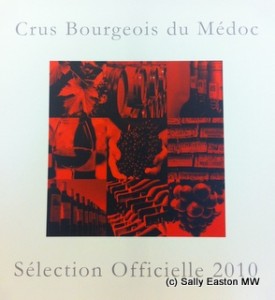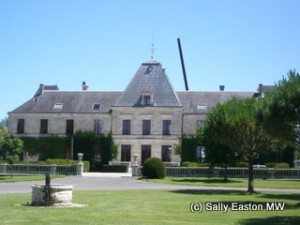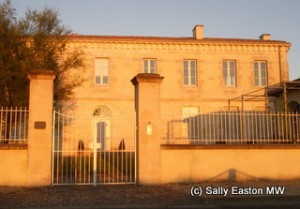The new Crus Bourgeois – three years in
A version of this article first appeared in The Drinks Business, September 2012.
 With the cancellation of the 2003 classification in 2007, the cru bourgeois moniker in Bordeaux was due for extinction, but was saved via a third-party accredited, transparent scheme. “Certification rather than classification, was the only way to keep [the term] cru bourgeois in the Médoc” said Olivier Cuvelier, of negociant H. Cuvelier et Fils, and vice president of the cru bourgeois Alliance.
With the cancellation of the 2003 classification in 2007, the cru bourgeois moniker in Bordeaux was due for extinction, but was saved via a third-party accredited, transparent scheme. “Certification rather than classification, was the only way to keep [the term] cru bourgeois in the Médoc” said Olivier Cuvelier, of negociant H. Cuvelier et Fils, and vice president of the cru bourgeois Alliance.
As the Alliance announces their third results, with the 2010 vintage, of this now-annual certification based on a blind tasting some 18 months after the vintage, how is the system distancing itself from the acrimony and politicking that surrounded the four-year legal battle which saw the 2003 classification annulled?
The mood is generally positive with open acknowledgement of the system’s options for improvement. At the time, said Martine Cazeneuve, owner of Château Paloumey “we needed strict traceability. We chose Bureau Veritas which was expensive and drastic and the only way for cru bourgeois to become legitimate again, and for us to regain our credibility, both for the market – courtiers, negoce – and for consumers.” And now, issues and evolutions are openly displayed on the table, the big ones being around the blind tasting required to qualify, a possible ranking and greater stability.
Discussions about the introduction of a ranking emerge from the fact that cru bourgeois is neither an homogenous nor a small group, and prices vary widely, from around €4 to €20 per bottle to the negociant. Cazeneuve said “we will try in a few years to at least have a superieur category but it is blurry at the moment. We are not all producing the same quality of wine [so] it would be good to have a small differentiation.”
The single level of the new certification was one of the things that deterred the ex-exceptionels from joining the new cru bourgeois. Another, said Edouard Miailhe of Château Siran was the tasting – “it’s difficult to take the risk of not being classified the following year.”
Interestingly, non-joiners of the new system would not be averse to rejoining an evolving cru bourgeois. A ranking might tempt Miailhe back into the cru bourgeois fold. Frederic le Clerc, of Château Tour de By might also be tempted back “if the system evolves in a positive way.”
Le Clerc had been deterred by the blind tasting, and it’s this that comes in for the most stick. The tasting, of bulk wine, takes place between February and July in the second year after the vintage, and châteaux can submit several times, so if they fail the first tasting, a re-submission tasted later may pass.

Château d'Arsac
Le Clerc said the “blind tasting can bring a standardisation of taste, and in a big area such as the Médoc, it’s important to have different types of taste.” Patxi Miguel, director at Haut-Medoc Château le Monteil d’Arsac suggested the tasting panels prefer relatively powerful, woody wines, saying “I presented the wine without oak, twice and it failed [twice], then I put the same wine with oak and it passed. We want to be cru bourgeois, so we will continue to make it with staves.” Frédérique de Lamothe, director of the cru bourgeois Alliance explained the benchmark quality level, set by a selection of 16 wines drawn from 80, tasted blind, includes un-oaked wines, but perception exists of a preferred style of the panel jurors.
Additionally, for a property preferring to bottle early in that second year such as Château Charmail, this caused a problem for their 2009 vintage. The sample was sent in, the wine bottled, but the sample failed. Bottled wine could not be submitted for tasting, so for 2009 Charmail has no cru bourgeois status, which may baffle consumers. The Alliance has since amended the rules to give one re-sampling opportunity in bottle, so the situation should not recur, but it does mean properties have to carefully consider their bottling schedule.
Such things are a heavy logistical burden, so, said Jean-Christophe Mau, of Château Preuillac, “we need to find a solution to stabilise the image of cru bourgeois. If a château stays cru bourgeois for [each of] five vintages, it would be nice if the château then stays cru bourgeois for 10 years.” Even if this one idea were adopted immediately, the system would remain as it is now for another two years. Evolution will not be rapid.
Despite such work in progress, producers are convinced quality has improved. Notwithstanding differing levels of quality within the certification, Jean-Baptiste Cordonnier, of Château Anthonic and Dutruch Grand Poujeaux, said it is “a guarantee for consumers that the wine will be higher quality than mass production of Bordeaux.” François Nony of Château Caronne Ste Gemme added “we’re sure the average quality of cru bourgeois today is much better than ten years ago.”
Guillaume Cottin of Dubos negociant agreed, saying “before, you didn’t need to do good quality every year. Now it is not possible to find bad cru bourgeois. And you can buy it at a good price and be sure [someone else] cannot find cru bourgeois at half of this price.” Now, he added “there is less competition with the price, and more competition with the quality.”

Château Branas Grand Poujeaux
The other big win for consumers is the largely steady prices of cru bourgeois wine. Cottin said “there’s never speculation with cru bourgeois. The people who buy cru bourgeois buy it to drink it.” Nony added “at the end of the 1970s we sold for half the price of Ducru Beaucaillou. Now we are 15 times less”.
And three years in, producers rave about collective marketing benefits. A first visit to China in 2011 saw 96 châteaux attend or send their wines. Nony said “all the rising markets that need something to hang onto understand and like the cru bourgeois because it’s value for money and accessible.” And for less well known appellations and producers this ranks high among the reasons for applying for cru bourgeois status. While Cazeneuve does not submit Margaux appellation Château La Bessans, she does her Moulis-en-Médoc property Château La Garricq “because [La Bessans] doesn’t need cru bourgeois; it sells itself. But it is easier to sell Moulis cru bourgeois than Moulis full stop.”
In a similar vein, Château La Branne owner Fabienne Videau, who has only been bottling their wine for just over a decade, said the benefits for a little known property of “being in a big tasting with other cru bourgeois opens our minds to do different things. And having the connections through the promotions organised by the Alliance lets us meet other winemakers, commercial buyers, journalists.” Without the cru bourgeois, she said “we would remain here [up in the far north of the Médoc], alone apart from tourists” so the exposure for improvement-orientated family owners is vast. In a traditional market with a huge number of well-known, well-established names this is no small fry.
A relaxed, and far from complacent, mood pervades the humbler and higher cru bourgeois, like a job being steadily done. Indeed president of the Alliance, Frédéric de Luze, and owner of Margaux property Château Paveil de Luze acknowledges that while “everything is going well, there are lots of things to improve. We have a few plans we’re working on, if not next year then the year after.”
My research visit to Bordeaux was sponsored by the Alliance des Crus Bourgeois du Médoc.



